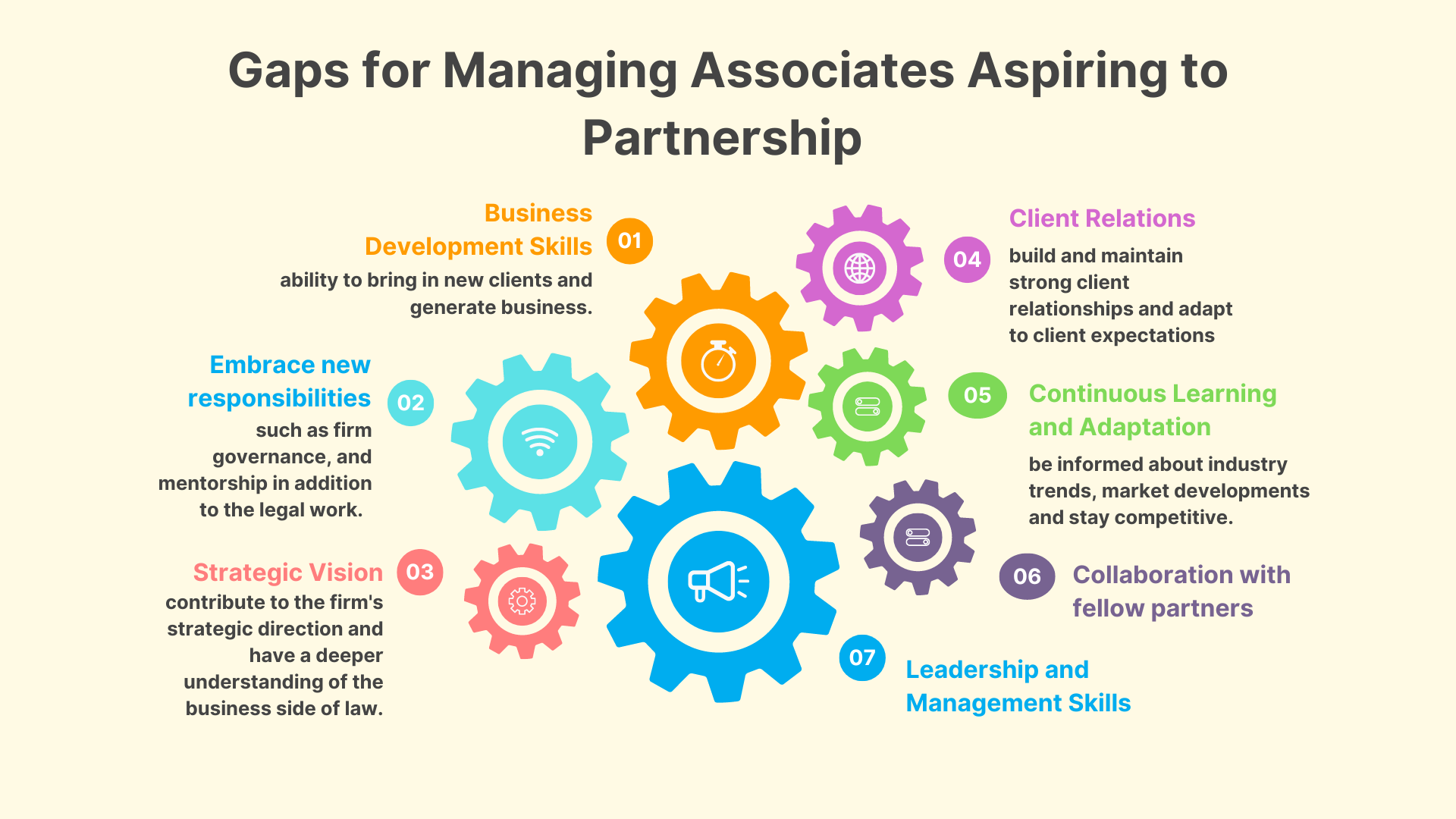For many legal professionals, becoming a law firm partner is a major career milestone signifying not only recognition for exceptional competence and a proven track record of delivering results but a transition that requires careful planning and strategic positioning. While it is heartening to read about these promotions in legal publications and on platforms like LinkedIn, the journey to partnership is rarely a straightforward one.
Compounding this journey is the increasing trend among law firms looking for partners with a profitable book of business when hiring laterals. Unfortunately, as the need for partners increases, there is a noticeable shortage of qualified candidates. This gap between demand and supply presents challenges and opportunities for legal professionals striving to achieve partnership.
This article is designed to explore the key dynamics of effectively navigating this journey, offering insights on what legal professionals can do to prepare themselves effectively to win a place at the partnership table.
A major challenge that is bound to be experienced by new partners is the transition process itself. Transitioning from the position of a managing/principal associate, in which an individual is more likely to be involved in executing legal work and client management under supervision, to that of a partner involves a significant shift in responsibilities.
Satish Kishanchandani, Founding & Managing Partner at Pioneer Legal, explains, “There is a general perception in the market that partnership is the top of the chain and therefore you no longer need to work hard. The reality is quite the contrary. You are put in a position of larger responsibility, which includes bringing clients, delivering work, looking after a team, and you actually need to work harder to ensure that the team is happy. It’s quite the role shift. One which most people are not ready for.”
There are mostly two groups of partners in a law firm, namely the salaried partners and equity partners. While the two roles are intertwined, each group carries specific responsibilities concerning ownership and decision-making. By being involved in key firm decisions, the equity partners foster heavy interest in the firm’s success by influencing strategic decisions, governance, and long-term planning. On the other hand, salaried partners are mainly involved in managing teams, handling significant cases, and mentoring junior lawyers, thus, ensuring operational, quality, and organizational stability to deliver quality legal services and effective team management.
Both roles are critical for every law firm and many salaried partners aim for equity positions once they demonstrate performance and business acumen by proving their ability to generate business, showcase professional expertise and leadership, expanding client relationships thereby contributing to the firm’s growth.
Growing As A Legal Professional
Navigating the transition to partnership and truly thriving as a partner requires moving beyond the role of a glorified managing associate and taking on a more proactive approach toward cultivating new skills and expertise.

“Business development is a habit that should be cultivated early. When you make principal associate/ managing associate, you need to start thinking about where the next job is going to come from, where the next client is going to come from. It is stressful. You need to get used to feeling that way 24/7. Hopefully by the time he/ she makes partner, it’s already ingrained”, says Kishanchandani.
When asked about the skills that partners need to effectively build and maintain a strong client base, Kishanchandani highlights, “The ability to build relationships, network with ease, and the ability to make sure that when a client thinks of a job, yours is the first name that pops into his or her head. It takes a lot of effort and different people have different ways of achieving this.”
Firm Culture & Expectation – What Can Law Firms Do?
In the practice of law, where most firms follow the “eat what you kill” model, fostering a culture of collaboration and cross-selling can be particularly challenging. Rajesh Narain Gupta, Founder & Chairman of SNG & Partners, comments, “It’s not an easy subject and this depends on a number of factors, including the firm culture and the number of equity partners and working partners. This is where constant training and matured in-house policies on a collaborative approach and cross-sell helps.”
According to him, there has to be a right mix and philosophy that respects those who source and maintain client relationships, those who execute the work, and the support staff. Mr.Gupta suggests that all relevant partners and team members should be marked on the communication with the client, not only for the first transaction but also for repeat transactions. This ensures that no one feels left out or cheated in the process. Additionally, equity partners need to work hard to cultivate the right culture within the firm, preventing animosity and ensuring a small percentage of earnings goes to a common pool.
On the topic of why many firms lack rainmakers and partners with a substantial client base, Mr.Gupta explains, “There is huge growth in the number of law firms in the country. Relationships play an important role for any law firm to get the business and open doors to meet a client, but this needs to be backed by the right knowledge, experience, talent, cost structures, and infrastructure. Clients expect to see depth in the partners’ experience and whether the right quality at the right price will be delivered or not. Ideally, a law firm should be built with the right experience and talent in the practice areas the law firm wishes to get into.”
Mr.Gupta further adds when asked how law firm partners can attract and retain clients, “Once the specialization and experience of the practice area(s) is demonstrated with the infrastructure to deliver, the Clients are motivated to work with the firm. Effective communication with the potential clients, presence at the right networking forums, and demonstrating the skill sets, and the nature of transactions undertaken on appropriate platforms help. Each firm has a character which is the reflection of how the senior partners of the firm are perceived by the Clients. Traits like humility, approachability, and a solution-oriented mindset significantly contribute to a firm’s attractiveness to clients.”
To ensure that managing associates meet the expectations required for becoming partners law firms can adopt the following approaches:
- Defined Career Paths: Implement career development programs that facilitate the transition of managing associates, to partners.
- Tailored Training Programs: Develop training initiatives focusing on skills and knowledge needed for partnership, such as leadership, business development, and client management.
- Mentorship and Coaching: Provide mentorship from partners to guide associates offering insights and feedback, on their performance areas in need of improvement.
- Leadership Development: Offer training to equip associates with the skills to effectively lead teams to manage projects and cultivate client relationships.
- Establish Clear Performance Metrics: Set measurable standards, for partnerships that match the firm’s objectives and principles and assess associates based on these criteria to confirm they are making progress. These benchmarks should cover legal skills as well as interpersonal abilities like teamwork and communication.
- Seek Client Feedback: Gather feedback from clients about associates’ performance to ensure they are meeting client needs and fostering client connections.
- Evaluate Cultural Alignment: Assess whether associates align with the firm’s culture and values as cultural compatibility is vital for long-term success and effective collaboration within the partnership.
- Support Business Development: Offer resources and assistance for business growth aiding associates in building their client base and contributing to the firm’s expansion.
- Succession Planning: Introduce succession plans to ensure a transition when associates transition into partnership roles focusing on maintaining continuity and stability.
Though titles may differ, what matters is understanding the responsibilities, decision-making power, and compensation tied to each role. Clear and open communication within firms can ensure that legal professionals are properly recognized and rewarded for their contributions.




